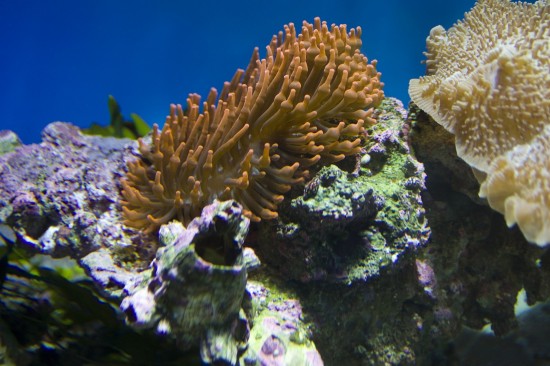Blue-Ringed Octopus Description
As their name tells us, the Blue-Ringed Octopus is well noted by the fact that they have a bluish ring around their body. This ring can also be black in color. They have skin that is a shade of yellow with those rings around it. The depth of the rings can often tell you how old the Octopus is. Due to the coloring, many people think they are seeing some type of mold growing in the water and not an Octopus.
Blue-Ringed Octopus Distribution
The Blue-Ringed Octopus is found in a few areas around the world. They are mainly present in the Pacific Ocean. Yet their habitat spans all the way from Japan to Australia so they have quite a presence.
Blue-Ringed Octopus Behavior
This is one species of Octopus that is dangerous due to the venom it releases. They are more aggressive than other species. While most types of Octopus will run and hide when danger is present, this one will bite first and ask questions later. It is an instinctive nature for them.
They also don't tolerate other Octopus around them. Their interactions can sometimes overlap while looking for food or shelter. With most species of Octopus they will pass each other without much recognition at all. For this species though they will become aggressive with each other for the dominance in a given location.
Blue-Ringed Octopus Diet and Feeding
The diet for these Octopus covers many different items so they normally don't have too much of a problem finding enough food. They hunt at night just like all other species of Octopus. Some of the items they commonly consume include hermit crabs, shrimp, and various type of small fish.
They are very fast predators with the element of surprise being on their side. They inject venom into the body of the prey and that will immobilize them. They use their beaks to break through the shells and to break the food source into small pieces that they swallow.
They have been known to eat each other too if they find that their other sources of food are hard to find. This is a common problem when these animals live in captivity. However, many experts believe it has to do with them living in too close of proximity to others instead of for the need to feed.
Blue-Ringed Octopus Reproduction
This are isolated animals in the wild, with the one exception being during mating season. The male and female will engage in mating several times over the course of a couple of days. The males will want to linger and continue to mate so the females have to become very aggressive in order to break away.
The females will lay approximately 50 eggs at a time close to the onset of spring. The eggs won't be released to the water though but remain in the safety of one of her arms where they can be warm and protected. She won't eat during this period of time so once they hatch she will die.
Blue-Ringed Octopus Human interaction
The Blue-Ringed Octopus is the only species identified as creating a venom that is deadly enough to kill humans. That makes them one type of Octopus that people want to stay very far away from. While these animals aren't aggressive and don't go after humans, they will attack in order to defend themselves. They may mistake humans as a food source and bite them by accident too.
They are considered to be one of the most venomous creatures in the world. Some people have been bitten by them after accidentally stepping on them in the water. The fact that these Octopus do blend in so well to their surrounding can make that an easy scenario to fall into.

 Labrador Retriever Hereditary Health And Health Testing
Labrador Retrieve
Labrador Retriever Hereditary Health And Health Testing
Labrador Retrieve
 The Personality Traits Of The German Shepherd Dog
The Personality T
The Personality Traits Of The German Shepherd Dog
The Personality T
 Your Marine Aquarium And Live Rock
Your Marine Aquar
Your Marine Aquarium And Live Rock
Your Marine Aquar
 Why Might A Fearful Dog Suddenly Become Bolder?
Why Might A Fearf
Why Might A Fearful Dog Suddenly Become Bolder?
Why Might A Fearf
 2 Breeds Of Cat That Boast Longer Lifespans
2 Breeds Of Cat T
2 Breeds Of Cat That Boast Longer Lifespans
2 Breeds Of Cat T